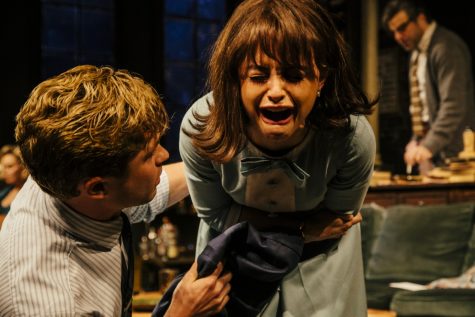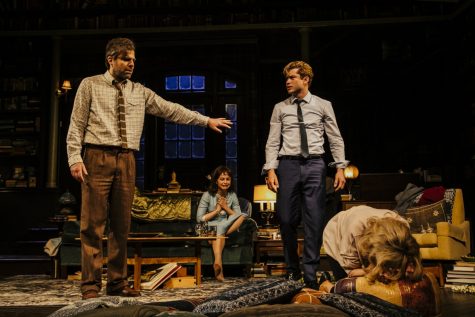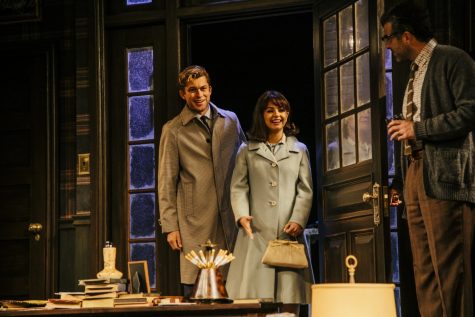Your donation will support the student journalists of Huntington Beach High School. Your contribution will allow us to cover our annual website hosting costs.
Thank you for supporting our program!
“Who’s Afraid of Virginia Woolf? Virginia Woolf! Virginia Woolf!”: A Review
June 8, 2022
Celebrating the play’s 60th anniversary, the Geffen Playhouse showcased Who’s Afraid of Virginia Woolf? on April 19th, 2022. Directed by Gordan Greenberg, this classic modern play follows the trials and tribulations of George (Zachary Quinto) and Martha’s (Calista Flockhart) deteriorating marriage as they drag a young, successful couple (Graham Phillips and Aimee Carrero) down with them. This 3-act play budding with symbolism and metaphorical dialogue brilliantly explores themes of family, heartbreak, childbirth, love, anger, and hysteria while maintaining an incredibly realistic tone and style that sends shivers down the spines of onlookers.

Quinto grabs the audience’s attention with his exceptional portrayal of the troubled, overly-competitive George even in a star-studded cast. The language of sarcasm and quick wit in the script flows effortlessly out of Quinto and his grasp on naturalist acting makes the audience question their own little mannerisms and nuances. Quinto’s ability to bring the audience into every thought and emotion he feels while still surprising them is something to be admired and sought after by any aspiring, young actor.
Flockhart’s characterization of Martha, an equally-competitive and stubborn partner to George, brought the energy and fluidity that the production relies on. While the character herself served to annoy and anger the audience with her actions, Flockhart’s performance made the audience want to watch her live through her character. Her moments alone on stage are just as captivating as her scene work with others — Flockhart’s individual connections to each person on stage and in the audience drive the emotion of the show forward. Watching her desperately grasp at power when she is primarily referred to as a wife or a daughter is depressingly captivating.
Phillips successfully sells Nick’s two-faced persona on stage without falling into the trap of being too cartoonish — his dazzling smile opposed by the dead look in his eyes is akin to Christian Bale’s Patrick Bateman in American Psycho. It was easy to see how his fake politeness made him a weapon for both George and Martha to use against each other when he never fully stood up for himself, just defended his own self-interests before having another drink or cigarette. He was brilliantly cast, from his golden boy looks to his active presence on stage for others to jump off of.

Carrero embodies every beautiful, sweet aspect of Honey that audiences love to feel incredibly piteous for. Watching Carrero’s little reactions and gestures that make Honey feel real is effectively heartbreaking and captivating — it is difficult to look away as she breaks down from the pressure that the other three place on each other. Her slow and steady adventure into becoming black-out drunk is arguably the strongest in the cast and her ability to balance physical comedy with gut-wrenching grief is astoundingly impressive.
Upon entrance into the theater, the audience is immediately met with a lovingly crafted set rife with minute details that later become relevant as the story plays out. Compared to high school productions, it is clear that there is a significant difference in budget. With its slanted, coffin-shaped ceiling, the room in itself evokes feelings about the dead-end nature of heterosexual marriage, and perhaps even alludes to the state of the main couple’s dreams about conception and family. The middle of the set features a “front door,” a beautifully made piece with a cloudy windowpane through which you can see the blurred picture of a figure standing behind the door. As the play begins, it is after we first see these lively blurs that the front door opens, and the audience is greeted with Martha’s disgusted opening line as she surveys her home — a two-story house with a mini-bar in the corner of the living room and empty glasses scattered in every (emphasis on every) corner — “Oh, what a dump!”

Director Gordon Greenberg makes use of the space given to him through the set — a doorway that suggests the entryway to a hall, stairs leading up to the second floor — by having the characters scramble around the house, moving from room to room. A particularly haunting image is the yellow light coming from the left side of the stage, casting long shadows that linger behind George and Martha as he leads his dazed wife up the stairs when the sun finally rises. Overall, the set has a cluttered, live-in feel to it that speaks to the level of familiarity shared between George and Martha and the baggage that weighs down their relationship.
The effects that the Geffen Playhouse integrated into their production brought the audience into their dysfunctional home and, by the time the play ended, viewers leaving at 11 pm were convinced that it was dawn: right where the play left them off. Between breaking glass bottles and the smell of cigarette smoke wafting from the stage to the audience, the entire theater time-travels back to the 1960s and easily empathize with the feeling of slowly but surely losing their minds. Even in the first of three acts, the terrifyingly sudden act of George aiming a shotgun at Martha’s head, only for it to be a cheap party trick, felt within the vein of realism that Who’s Afraid of Virginia Woolf? establishes so brilliantly.
Virginia Woolf was an incredibly important English modernist writer, renowned for her stream-of-consciousness style of writing and contributions to early 20th-century feminism. With this information in mind, it is not immediately obvious what relevance she has in the play to warrant being a titular character, despite never making an appearance on stage. Upon further analysis, it becomes clear that Woolf’s impact on the play is not so heavy-handed and her influence permeates every minute detail of the script.

The dialogue between characters in Who’s Afraid of Virginia Woolf? is full of subconscious reveals and endlessly flowing banter seemingly without any filter. The characters’ manner of speaking draws directly from Woolf’s stream-of-consciousness writing technique, wherein she employs the use of internal monologue in her narration to reveal complex thought processes akin to the consciousnesses of actual human beings. This adds a layer of quick-wittedness to each character interaction and gives the audience the impression that they are getting unique glimpses into the characters’ minds. As a historic influence, Woolf’s own inability to have children looms over the themes of this play as well. Woolf’s husband and psychologist were said to have apparently deemed her unable to have children due to purported psychological issues, which is something that is reflected in Martha’s own inability to have children — and her subsequent imagined son.
The phrase “Who’s afraid of Virginia Woolf?” is sung to the tune of “Who’s afraid of the Big Bad Wolf?” from Disney’s famous cartoon Three Little Pigs, and serves as a poignant allusion to Woolf’s own relationship with motherhood as well as the underlying fear that eventually George or Martha is going to slip up — and say something they actually mean.
Taking place in the 1960s, the nuclear family model plays a large role in this show, as every character’s actions reflect the societal demand of fulfilling their American responsibility to have children, regardless of the state of their marriage. The looming threat of divorce rates on the rise, women’s appointed position as a side character in their own lives à la Sylvia Plath, the overwhelming pressure to appear cordial and kind to strangers regardless of abundant marital problems — these pillars of the nuclear family model overtake the lives of the characters in this show until they are driven to extreme alcoholism, hysteria, and depression. The audience can almost physically see the seams of each individual marriage tear apart, coming to a climax as Honey stares into the audience, crying and holding a bourbon bottle like a baby as she cries out, “I want a child. I want a child! I want a baby!”
George and Martha’s particular obsession with having children makes way for the play’s inciting incident where Martha tells Honey offstage about their son, breaking the promise that the couple made to never speak of him. George’s grabs at control over the room come from his need to prove himself as a man, seeing as he cannot conceive a child and, by the ineffable rules of the nuclear family, that makes him a worthless member of society. George’s delirious and deranged actions feel ungrounded and extreme on the first watch, but more devastatingly understandable by the second viewing — all credit to Quinto’s performance. On the other side, Martha makes desperate attempts as a woman to take power away from George, from holding her father’s power over her husband’s head to provoking him with every bone in her body to stop her from bringing Nick upstairs with her to their bedroom. Martha is aware that she holds more power than the average wife in her relationship but she still wants more and clearly will never be satisfied even if George submitted to her. The push-and-pull that the couple experiences feels otherworldly to both the audience and the young couple onstage, but is one of the best depictions of an extremely toxic and dysfunctional yet astonishingly captivating and real couple that can be observed in media.

Children — or lack thereof — are an important component in the conflict not only between the couples themselves but in the themes of the play as a whole. Beyond a societal expectation, the ability to have children is something that is inextricable from the definition of womanhood (that is, an outdated, non-inclusive definition) under a patriarchal society, especially considering the time period of this play. Both Martha and Honey’s failure to have children to fulfill this societal expectation set for women and the nuclear family ideal that denotes success in the eyes of society puts a strain on both of their marriages. This has embittered Martha’s marriage to George, filling it with the snide remarks and alcoholism that have become so familiar to the audience throughout the show’s runtime, and that promises an unhappy ending for Honey and Nick, whose entire marriage is built on the foundation of this “failure.” Martha copes with her lack of children by playing a game of pretend with George, wherein her son is all grown up and distant from his emotionally unstable parents. This game is a source of contention between George and Martha, a reminder of the unfulfilled dreams that ultimately ruined them.
One of the harshest realities that the audience observes throughout the show is the deterioration of the young budding couple, Nick and Honey, who simply wanted to make new acquaintances after a university staff party. While in their entrance they are holding each other close and enjoying each other’s company, by their exit, they cannot even bear to look at each other. George and Martha are a look into the future for these promising young people, and the second they realize it, the audience cannot help but feel a pit in their stomachs. Through George’s influence, Nick stabs his wife in the back and reveals that he never felt any sort of love for her when they were married, only an obligation to cover up a false pregnancy scandal; through Martha’s influence, Honey begins her journey of intense alcoholism and disdain for even the purest actions of her husband. George and Honey bond on a couch as they wallow in their own misery, watching their partners dance proactively with each other. What is curious is that though Honey and Nick leave absolutely disgusted with each other and presumably ruined forever, Martha and George leave embracing and comforting each other after one of the worst moments of their lives. There is still some semblance of love between the older couple, perhaps through the years they accumulated it, perhaps they are aware that no one else could ever keep up with them the way their worst enemy of a partner could — whatever the case is, Honey and Nick do not share that connection.
The show ran in the Geffen Playhouse in Los Angeles from April 19, 2022, and was extended by popular demand to May 29, 2022. To see other shows produced by the Geffen Playhouse, be sure to check out their website: https://www.geffenplayhouse.org/shows/whos-afraid-of-virginia-woolf/!

